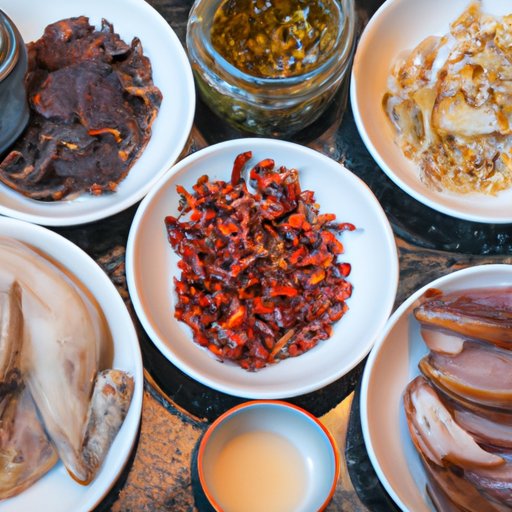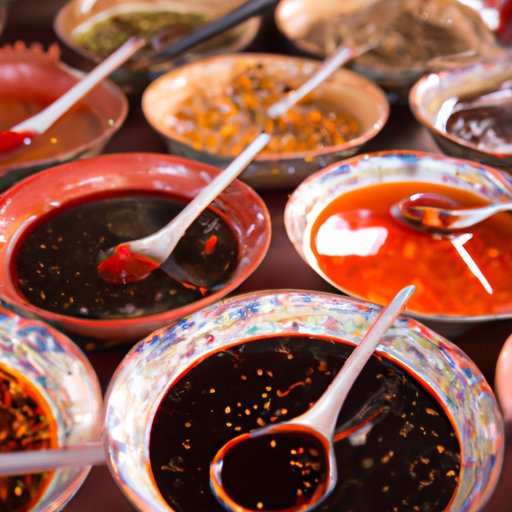
I. Introduction
Duck sauce is a quintessential condiment in Chinese cuisine. Sweet, tangy, and fruity, it is used as a dip, spread, or accompaniment to a wide range of dishes, including roasted meats, egg rolls, dumplings, and stir-fries. In this article, we’ll explore everything you need to know about making duck sauce, including its history, nutritional value, popular ingredient variations, and creative ways to use it beyond Chinese dishes.
II. A Step-by-Step Recipe Guide to Making Duck Sauce from Scratch
To make duck sauce from scratch, you will need:
– 1 cup apricot preserves
– 1/4 cup honey
– 2 tablespoons rice vinegar
– 1 tablespoon soy sauce
– 1 teaspoon garlic powder
– Pinch of salt
– 1/4 teaspoon cayenne pepper
To prepare the sauce, follow these steps:
1. In a saucepan, combine the apricot preserves, honey, rice vinegar, soy sauce, garlic powder, salt, and cayenne pepper.
2. Over medium heat, bring the mixture to a boil, stirring frequently.
3. Reduce the heat and let the sauce simmer for 5-10 minutes, or until it has thickened to your desired consistency.
4. Remove from heat and let the sauce cool to room temperature before serving.
Storage: Store the sauce in an airtight container in the refrigerator for up to two weeks.
Alternative ingredients: You can substitute the apricot preserves with other fruit preserves, such as peach or pineapple. You can also use fresh fruit puree instead of preserves.
III. The History and Evolution of Duck Sauce
Duck sauce has its origins in Chinese cuisine and is believed to have been introduced to the United States in the early 20th century. Early versions of the sauce were made with dried red plums, which were boiled, mashed, and mixed with sugar. Over time, the recipe evolved, and apricot became the fruit of choice.
Today, there are many variations of duck sauce, with recipes varying from region to region in China and across the globe. Some versions include additional ingredients like ginger, sesame oil, or chili flakes.
IV. Popular Ingredients Used in Making Duck Sauce
The main ingredient in duck sauce is typically apricot, which provides the fruity and sweet flavor profile. Other ingredients commonly used in duck sauce include:
– Rice vinegar: Provides acidity and depth of flavor.
– Soy sauce: Adds saltiness and umami.
– Honey: Enhances sweetness and smoothness.
– Garlic powder: Contributes a savory note.
– Cayenne pepper: Adds a bit of heat.
V. The Nutritional Value of Duck Sauce
Duck sauce is high in sugar, with most of its calorie content coming from carbohydrates. While it does not provide significant nutritional value, it is low in fat and protein. It is best consumed in moderation due to its high sugar content.
An alternative way to use duck sauce is to incorporate it into other dishes as a flavor enhancer, such as marinades or dressings.

VI. Different Variations of Duck Sauce Around the World
Duck sauce is not limited to Chinese cuisine. Other cultures have their variations of the condiment, including:
– Hoisin sauce (China): Made with soybeans, garlic, vinegar, and chili paste, this sauce is richer and darker in flavor than traditional duck sauce.
– Plum sauce (Japan): Similar to duck sauce in texture and flavor, but made with Japanese plums and often served with sushi or as a glaze for grilled meats.
– Tamarind sauce (India): Made with tamarind pulp, this sauce is more sour than sweet and is used as a dipping sauce for samosas or other fried snacks.
– Mango chutney (India): Made with sweet and sour mangoes, this sauce is often spiced with cumin or ginger and served with curries or as a spread on bread.
– Chilean pebre (Chile): Made with chopped tomatoes, onion, and cilantro, this spicy condiment is similar in texture to salsa and is served with meat or bread.
VII. Making Duck Sauce in Bulk and Storage Tips
To make duck sauce in bulk, simply scale up the recipe while still maintaining the same ratios of ingredients.
To store duck sauce, transfer it to an airtight container and keep it in the refrigerator for up to two weeks. For longer-term storage, freeze the sauce in small batches in a freezer-safe container and thaw as needed.
VIII. Creative Ways to Use Duck Sauce
– Use it as a marinade: Brush duck sauce on chicken, pork, or tofu before baking or grilling for an Asian-inspired twist.
– Use it as a glaze: Drizzle duck sauce over roasted root vegetables or grilled salmon for an unexpected burst of flavor.
– Use it as a dip: Serve alongside vegetable crudites, chips, or pretzels for a snack that’s both sweet and salty.
– Use it as a spread: Spread duck sauce onto sandwiches or wraps for a quick and easy lunch.
– Use it as a dressing: Mix duck sauce with oil and vinegar for a fruity and tangy salad dressing.
IX. Conclusion
Making your duck sauce is an easy and fun way to add flavor to your dishes. Whether you’re a fan of Chinese cuisine or looking for a new twist on old favorites, duck sauce provides a sweet and tangy flavor profile that pairs well with a wide range of ingredients. We hope this guide has inspired you to try making your own duck sauce and experimenting with its diverse uses.




